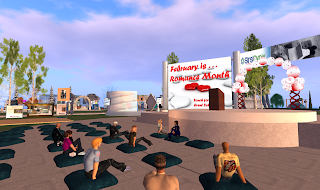The non-credit course consists of four sessions offered on Sundays, February 1, 8, 15 and 22 from 6:00 - 8:00 P.M. (4:00 - 6:00 P.M. SL time). The course is to cover objectives such as planning, needs assessment, goals, expectations, buying and renting land, where to find help, prefab vs. building, challenges, positives, teaching tools in SL such as Power point, class management, groups permissions, communication, and evaluating your presence once you have it set up. I haven't evaluated my presence in real life, let alone a second life. :-)
Instructors for this course are Lori Bell (Lorelei Junot-SL), Rhonda Trueman (Abbey Zenith-SL) and Tom Peters (Maxito Ricardo-SL). Each week is organized to cover the following:
- Week One - Planning a presence in Second Life
- Week Two - Setting up a presence in Second Life
- Week Three - Managing a presence in Second Life
- Week Four - Evaluating a presence in Second Life
For the first week session we gathered at the open air auditorium on Info Island http://slurl.com/secondlife/Info%20Island/116/126/33. Lori Bell ((Lorelei Junot-SL), who is the Director of Innovation for the Alliance Library System, led the first class session on planning a presence in Second Life.
The first session went very smoothly, voice (along with some text) was used for communication and worked quite flawless. Lori began the session with a short discussion on virtual worlds, identifying alternatives to SL. Resources including the Second Life Education Wiki (http://www.simteach.com/wiki/index.php?title=Second_Life_Education_Wiki) and Second Life Educators (SLED) listserv (https://lists.secondlife.com/cgi-bin/mailman/listinfo/educators) were identified as useful locations for information on SL.
We toured three locations in SL including Bradley University, Land of Lincoln and Bradburyville to view and learn about the design and setup of their space. At Bradley University we met Puglet Dancer, who teaches Second Life 101 and 201 and is the Director of the Library. The SIM is ran by a team of 1 IT/computer person, 4 Librarians and 1 student. Bradley University was created in 2006 through a grant to explore the possibilities of virtual worlds. Skyboxes, including viewers, are available to students that consist of 150 prims for them to develop building skills. The SIM is designed based on the campus colleges. Each college is represented by a kiosk including information on each college at the university. An interesting build on the campus is a Shinto Shrine. This shrine is used for religious studies and allows individuals to experience the shrine without seeing it in real life. The student centre includes games such as pool, air hockey and monopoly. Live concerts are held at the student centre with a dance floor on the rooftop. Puglet Dancer describes the learning curve of SL to be a huge obstacle in getting participation from faculty and staff. She also expressed that administration is concerned about people sitting in on classes without paying fees.
Land of Lincoln, the second location of our tour, is designed based on the topic of Abraham Lincoln. At this SIM we met Daisyblue Hefferman who is a Reference Librarian. The SIM or land was donated but the rest of the work was completed by volunteers. Some of the exhibits on the SIM include a plantation, slave quarters, army quarters, slavery interactive web tours, web-based resources and welcome centre including free outfits, events information and abiltiy to join the events group. Daisyblue Hefferman identified that preplanning a build is important and should include goals and objectives of the space.
The third location we visited was Bradburyville, a SIM designed and built based on books. This is a project funded by an arts grant and constructed by a team of four, working on individual builds. The build we looked at was a virtual reality book based on Fahrenheit 451 by Ray Bradbury. This was an interactive book that you walked into to experience the events of the story.
Next week we will be looking at setting up a presence in SL.







1 comment:
Hey Kirk! This looks great!! And to think that it's non-credit, but structured and with some clear objectives...hmmm. Could this be yet another example of a....let's call it....non-formal learning environment? I especially liked the comments: "Puglet Dancer describes the learning curve of SL to be a huge obstacle in getting participation from faculty and staff." and "She also expressed that administration is concerned about people sitting in on classes without paying fees." The latter is so typical, huh? Have fun! Dirk
Post a Comment